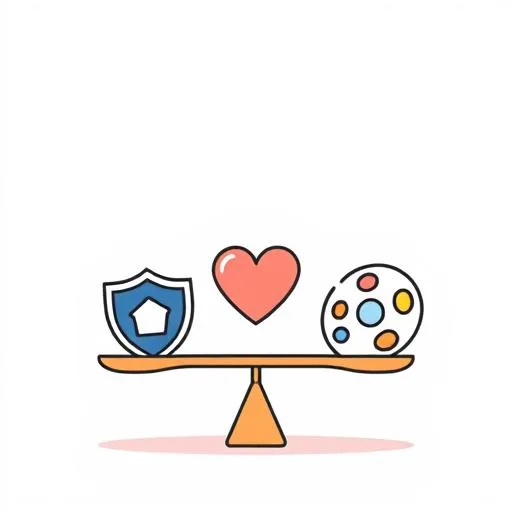
Imagine the sheer joy on your child’s face when they create their own fantastical world! That’s the magic we’re protecting. Picture this: your child spends an afternoon crafting a sparkling new world in Minecraft, adding custom skins and stories, then someone tells them it might be illegal. That’s the reality a well-meant bill could create. We’re talking about protecting the very heart of childhood imagination as we dive into how Reps. Dean and Salazar’s NO FAKES Act—meant to stop harmful AI deepfakes—could accidentally squish the creativity we cheer on every day.
When Good Bills Go Awry: Could This Hurt Kids’ Creativity?

Let’s chat about the Nurture Originals, Foster Art, and Keep Entertainment Safe (NO FAKES) Act. It’s got heart—really does. Aimed squarely at stopping malicious deepfakes, especially non-consensual explicit content, it promises to “empower victims” and “safeguard human creativity.”
But here’s where it gets interesting: what if it unintentionally criminalizes your kid’s favorite fan mods? Imagine explaining to wide-eyed innocence that their lovingly-crafted Skyrim character—inspired by grandma’s old stories—might now be legal dynamite. The research hits hard: gaming communities worry it’ll devastate creativity in timeless titles like Fallout: New Vegas and Minecraft where mods breathe new life into old worlds. Small developers and hobbyists would bear the brunt, not big studios.
Have you ever watched your child so absorbed in creating that time just disappears? That’s the spark we can’t risk dimming.
Why Pixelated Playgrounds Matter for Creative Development

Mods aren’t just pixels and code—they’re playgrounds for the mind. Remember the magic when your kid first stacked LEGOs into a spaceship? Mods are the digital version: tinkering with voices, textures, and stories becomes quiet lessons in problem-solving and empathy. A child tweaking Minecraft skins learns design; modding dialogue in New Vegas sparks narrative creativity.
And let’s be honest: sometimes those after-school hours spent building virtual worlds are the very moments they process big emotions or bond with friends over shared adventures. It’s that beautiful blend of tradition and innovation, like when families gather to share stories that now come alive in digital worlds.
But if well-meaning laws tangle play in red tape, we trade creativity for caution. Kids thrive when they remix reality, not when they’re boxed in by rules that miss the wonder of their world.
Walking the Tightrope Together: Balancing Safety and Play

We absolutely need guardrails against deepfakes—especially the vile ones targeting real people. No question. But as parents, we know nuance matters. How do we protect neighbors without penalizing the kid who made a silly voice mod of her teddy bear?
The bill’s sponsors say it “defends against sexually explicit deepfakes” while “embracing responsible innovation.” Yet gamers whisper worries: what if a child’s mod uses a voice that sounds vaguely like a celebrity? Suddenly, play becomes peril.
As parents, how do we reconcile our need to protect with our desire to nurture creativity? It feels like building a fence around a wildfire without trapping butterflies in the net.
Laws should shield, not stifle. We can’t let fear of tech’s shadows steal the sunlight kids need to grow their own creative fire. The real win is teaching them to spot fakes while still cheering their original ideas—like saying, “Wow, you made that? Now let’s talk about where those voices really come from.”
Nurturing Builders, Not Just Users: Practical Tips for Parents

So what’s a warm-hearted parent to do while lawmakers sort this out?
First: talk openly. Not with scary “the-internet-will-eat-you” talks, but curiosity. “Look at this cool mod—how do you think they made the dragon talk?” sparks critical thinking far better than blank bans.
Second: balance play with playtime. My favorite parenting win last week? Swapping “screens off now!” for “Hey, want to build a real-world fort first?” That modder energy? Redirect it. LEGO bricks, sidewalk-chalk art, funny-shaped cookies—creativity thrives offline too.
Finally: support safe spaces. If your child mods, explore platforms with clear rules against harmful content but clear lanes for non-commercial fun (like the bill’s intended “human-first safeguards”). Nurture judgment, not just restrictions.
The Bright Side of the Screen: Fostering Hope and Imagination
Let’s end where we began—with hope. Every time our kids remix a game or draw a new character, they’re not just playing. They’re planting seeds for the future: compassionate coders, storytellers who value originality, citizens who balance caution with courage.
What touches me most is seeing grandparents connect with grandchildren over creative mods, creating new family traditions across time. Laws like NO FAKES remind us protecting people matters—but so does protecting the space where imagination blooms.
Tonight, when your child fires up their favorite game, try this: “Show me what you made!” Listen to their spark, then gently ask, “What makes this yours?” That’s where real safety lives: not just in federal bills, but in the quiet trust we build together.
When we balance safety with creative freedom, we’re not just protecting today’s playtime—we’re nurturing tomorrow’s innovators, one joyful mod at a time.
Source: A Bill Meant To Crack Down on AI Deepfakes Could Get Gamers, Modders, and Small Developers in Legal Trouble, Reason, 2025/09/05 23:00:10
